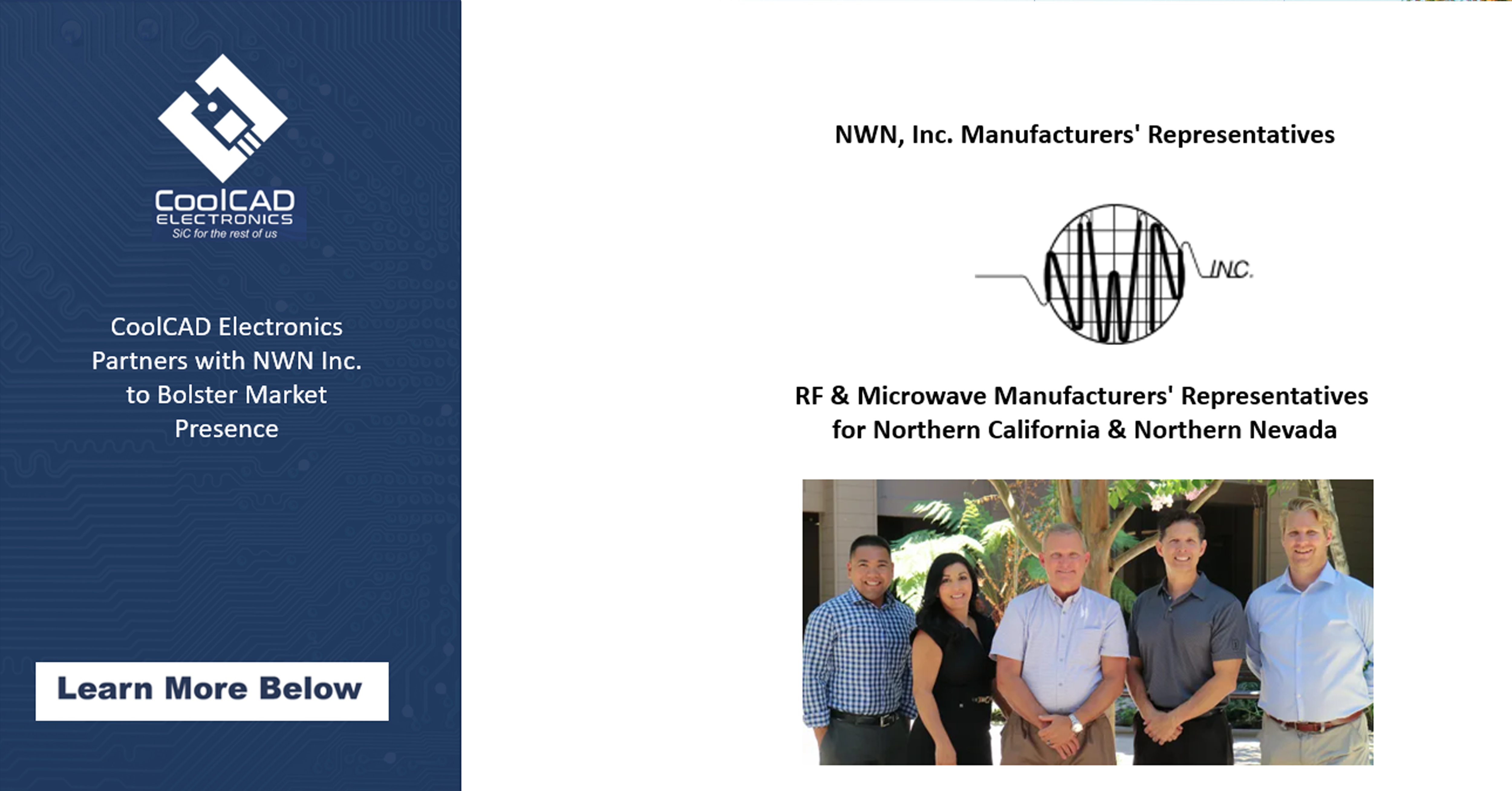Welcome to CoolCAD’s Power Newsroom
Our company is growing quickly as we expand our reach and develop new opportunities for SiC in the power semiconductor market. Please check back here often for information on our pioneering research, and don’t hesitate to reach out to us at [email protected] with questions.
Linear and Avalanche Diodes for Harsh and High-Temperature Environments
Photon detection technologies form the backbone of a wide array of modern instrumentation systems, spanning oil and gas exploration, geothermal energy harvesting, industrial flame detection, aerospace sensing and envionmental spectroscopy. These diverse application share a common demand: detectors capabile of resolving sometimes extreamely low-light or single-photon signals while surviving the potentially punishing mechanical and thermal conditions of their operating environments.
Press Release – CoolCAD Expands Silicon Carbide Portfolio with 3.3kV High-Power, High-Temperature Devices
CoolCAD Electronics, a leader in advanced Silicon Carbide (SiC0 device design and manufacturing, today annouced an expansion of its SiC product portfolio with the launch of new 3.3kV high-power, high-temperature MOSFETs and power components engineered for demanding energy, industrial, and transportation applications.
SiC Devices for ESD and Lightning Strike Defense
The rapid adoption of wide-bandgap semiconductors has fundamentally changed how engineers design transient protection for low-voltage electronic systems. Silicon carbide (SiC), long recognized for its high efficiency in power conversion, is now being leveraged for circuit-protection applications that demand exceptional denergy absorption, fast switching response and high-temperature reliability. SiC-based inline and parallel protection devices provide robust defense against electrostatic discharge (ESD) events and lighting-induced transients, ensuring the survivability of mission-critical electronics in aerospace, communications, and embedded environments.
Converting Power Electronics to SiC
Converting power electronic platforms from silicon Si or gallium nitride (GaN) to silicon carbide (SiC) has moved from theory to practice. Teams are doing it to gain higher efficiency, grater power density, and better thermal margins in traction inverters, fast chargers, industrial drives, photovoltaic inverters and grid storage.
From EVs to AI Data Centers, Silicon Carbide Powers the Path to Sustainability
Silcon carbide (SiC), once seen primarily as a disruptor in the electric vehicle (EV) market, is rapidly gaining ground in a new frontier: artificial intelligence (AI) data centers and the broader greeen energy transition. While the early 2020s were defined by SiC’s rise in EV powertrains and charging systems, the mid-2020s are showing an inflection point, one where the demad for high-efficiency, high-density power devices is coming from hyperscale data centers, edge computing, and renewable energy infrastructure.
CoolCAD Advances SiC Technology for Next-Gen Energy and Aerospace Systems
CoolCAD Electronics is pushing the boundaries of power electronics with its advanced silicon carbide (SiC) devices engineered for extreme environments. From grid-tied solar inverters to nano grid converters and high-radiation aerospace systems, CoolCAD delivers high-voltage, low-leakage solutions with proven resilience against terrestrial and cosmic radiation. Recent innovations include 1.2kV–3.3kV SiC MOSFETs, JFETs, and diodes with industry-leading reliability, tailored packaging, and optimized switching performance. As demand surges for rugged, high-efficiency power conversion, CoolCAD stands at the forefront, delivering custom solutions for tomorrow’s energy, defense, and space challenges.
The Future of Power Electronics is Here, and it’s Built on Silicon Carbide (SiC).
As electric vehicles, renewable energy systems, and industrial power platforms demand higher efficiency, reliability, and thermal performance, traditional silicon and GaN devices are hitting their limits. CoolCAD Electronics is redefining power conversion with advanced SiC solutions that deliver superior thermal conductivity, robust voltage handling, and unmatched durability in the harshest environments. Ready to see why SiC is the ultimate upgrade for next-generation designs?
Radiation Tolerant Silicon Carbide High Voltage Transistors for Switching Power Converters
To achieve massive weight and volume savingsin space and high-altitude missions, radiation-hardened high voltage and high power devices are needed. These devices would pave the way for higher vltages and frequencies in power converters and power distribution systems. For example, use of higher voltages would give rise to mass savings in the buss lines and solar array systems, and use of higher frequences woudl yield mass and volumen savings due to use of attendant compact passives such as capacitors and inductors.
CoolCAD Electronics and RFMW Announce Distribution Agreement for High-Power Silicon Carbide Semiconductor Devices
San Jose, CA, March 11, 2025 – RFMW, part of Exponential Technology Group, Inc., a premier distributor of power management and RF and microwave components serving the electronics industry, today announced a strategic partnership with CoolCAD Electronics to enhance its portfolio of high-power and high-voltage silicon carbide (SiC) semiconductor devices. This agreement strengthens RFMW’s ability to offer customers advanced wide bandgap solutions, enabling superior
Ultrafast ID-VG Technique for Reliable Cryogenic Device Characterization
An in-depth understanding of the transient operation of devices at cryogenic temperatures remains experimentally elusive. However, the impact of these transients has recently become important in efforts to develop both electronics to support quantum information science as well as cryogenic high-performance computing.
Radiation Hardening Power Semiconductor Devices.
In this paper, Dr. Akin Akturk delves into the critical issue of radiation-induced failures of power semiconductor devices utilized in space applications. He begins the discussion with an overview of NASA’s technology roadmap objectives for power and energy storage in space, underscoring areas requiring advancement. Both terrestrial and space radiation hazards are then examined, with an emphasis on modes of failure and current strategies for mitigation. Dr. Akturk further delves into technical challenges and promising outcomes revealed from testing that are influencing the direction of engineering efforts to harden semiconductor power devices against radiation. He concludes by discussing CoolCAD Electronics’ innovative silicon carbide (SiC)-based semiconductor design and fabrication approach that promises to deliver advanced radiation-hardened devices that will enable NASA’s ambitious technology roadmap objectives.
Revolutionizing High-Temperature Electronics: CoolCAD’s SiC CMOS Fabrication Breakthrough.
CoolCAD has pioneered a robust SiC CMOS fabrication process for high-temperature applications. Utilizing a patented process, CMOS circuits are fabricated on standard N+ wafers with epitaxial structures. Our in-house facility, upgraded for SiC processing, enables optimization of device characteristics.
CoolCAD Electronics Partners with Micro Technology Group Inc. to Enhance Market Presence in the Pacific New England territory.
College Park, MD, January 14, 2024 – CoolCAD, a leading provider of advanced semiconductor design and engineering soluons, today announced a strategic partnership with Micro Technology Group (MTG) Inc., a prominent business development company that provides technical markeng and sales soluons for the electronics industry. This partnership will enhance CoolCAD’s market reach and customer engagement across key segments of the industry.
CoolCAD Electronics partners with Spectrum Sales Inc. to enhance its market presence in the metropolitan areas of New York and New Jersey.
College Park, MD, January 13, 2024 – CoolCAD, a leading provider of advanced semiconductor design and engineering solutions, today announced a strategic partnership with Spectrum Sales Inc., a prominent technical sales and support company for the electronics industry. This partnership aims to strengthen CoolCAD’s market presence and enhance customer engagement within key sectors.
CoolCAD Electronics Enables New Applications and Opportunities with Silicon Carbide (SiC) Solutions
By Akin Akturk
The journey from the historic foundations of early NMOS and PMOS transistors to cutting-edge CMOS-VLSI smart technology showcases an industry with unwavering commitment to innovation. CoolCAD proudly continues to lead this charge, with our SiC-based transistors already delivering substantial high-performance improvements in the aerospace, automotive, defense, energy, and industrial sectors.
CoolCAD Electronics Partners with Wescom Marketing Inc. to Strengthen Market Presence
College Park, MD, December 18, 2023 – CoolCAD, a leading provider of advanced
semiconductor design and engineering solutions, today announced a strategic partnership
with Wescom Marketing Inc., a prominent technical sales and support company for the
electronics industry, to enhance its market reach and customer engagement across key
sectors.
CoolCAD Electronics Partners with NWN Inc. to Bolster Market Presence
College Park, MD, Oct 11, 2023 – CoolCAD, a leading provider of advanced design and engineering solutions, today announced a strategic partnership with NWN Inc., a renowned rep agency, to enhance its market reach and customer engagement across key sectors.
Transformative Innovations: – Bidirectional CLLC Resonant Converters and Advanced Materials in Power Electronics
Power electronics play a key
role in propelling military vehicles forward, with
bidirectional CLLC resonant converters emerging
as a transformative innovation.
Revolutionizing Power Electronics – Paving the Way to a Greener Future
Advancing Sustainability and Performance Across Industries with SiC and GaN Power Devices
The Next Generation of High-Temperature Integrated Circuits with SiC CMOS (to be presented at GOMACTech March 2023
By Dilli, N. Goldsman, C. Darmody, A. Akturk, U. Khalid, M. Gross, R. Purcell, E. Mountfort, Y. Kamali
Learn More
Abstract—We describe our work on Silicon Carbide CMOS device and circuit development for high-temperature applications above 400ºC. We focus on gate dielectric and gate stack development, optimizing doping profiles and processing methods to better integrate NMOS and PMOS devices, and studying long-term reliability. Our activities span the range from physics-based material, process, device and circuit modeling and simulation to design, layout, fabrication, and testing. We present some results and briefly describe some specific challenges and our approaches.
CoolCAD Awarded SBIR Phase II Contract for Radiation Tolerant High Voltage Silicon Carbide Switches
National Aeronautics and Space Administration August 2021
Learn More
As set forth in a recent NASA Technology Roadmap, the current state of the art for a space radiation hardened power distribution component is limited to below 200 V. To achieve the technology performance goal of above 300 V for the derated semiconductor operating voltage, new technologies are needed. An example immediate benefit of space hardened high voltage part is that they would enable next generation high-power electric propulsion systems. Use of a wide bandgap semiconductor such as silicon carbide is also likely to increase their efficiency.
CoolCAD Awarded SBIR Phase I Contract for Highly-Integrated SiC BiCMOS/Power Device Technology: Design, Modeling, and Reliability Metrics
Department of Defense July 2021
Learn More
We propose to lay the groundwork for the implementation of a completely integrated SiC BiCMOS/LDMOS technology for integrated control/power circuit applications reliable for operation up to 300 C. Our workplan to accomplish this goal comprises improving device speed and reliability by device engineering, establishing baseline reliability and qualification tests to support and certify development, and to build on our extensive background in physics-based device design and modeling to guide our designs, to extract models, and to start establishing a process design kit (PDK) for wide-spread application of this technology.
CoolCAD Awarded SBIR Phase I Contract for Dual Output Bidirectional Integrated DCDC Isolated SiC-based Power Converter for Space Applications
National Aeronautics and Space Administration (NASA) May 2021
Learn More
In the Phase I effort of this this work, we will conceptualize, design, fabricate and validate through simulation and preliminary experiments of a 8kW-rated silicon carbide (SiC) based galvanically isolated dual-output bi-directional DC- DC power converter circuit that can operate at a wide range of temperatures in space environments. Moreover, the design comes with a high degree of modularity and configurability of a proposed three-port network, where (a) multiple power converter units can be paralleled on the output side to scale up the power level, (b) planar magnetics technology is employed to enhance the power density and (c) power flow can be directed between any two specific ports while being able to bypass the third port.
CoolCAD Awarded SBIR Phase I Contract for High Temperature SiC Modular Power Conversion Platform
National Aeronautics and Space Administration (NASA) May 2021
Learn More
In the Phase I effort of this this work, we will commence the development of a power conversion modular platform for very high temperature (500C) and high-level radiation environments. We will design, simulate and fabricate key components of this configurable platform. We will also prototype a specific implementation of this power conversion platform as an example application for near term space missions. The platform is based on the nascent wide bandgap semiconductor Silicon Carbide that can operate at temperatures far greater than the capabilities of silicon-based electronics.
CoolCAD Awarded SBIR Phase II Contract for SiC CMOS Integrated-Circuit High-Temperature Sensing Platform with Enhanced Gate Oxide Reliability
Department of Defense February 2021
Learn More
CoolCAD Electronics designs and fabricates silicon carbide (SiC) MOSFET electronic devices that have been shown to operate at 500°C. In addition, CoolCAD has demonstrated that its SiC CMOS circuits work for extended periods at hundreds of degrees C without obvious degradation. CoolCAD Electronics is proposing to build on these successes to design and fabricate complex CMOS integrated electronic circuits which can operate reliably for long-term at 500°C, well beyond what conventional silicon electronics can withstand. Circuits to be built include analog-to-digital converters integrated with sensors and data registers, and digital circuits, such as gates, multiplexers, counters, adders and an
arithmetic-logic unit (ALU). The proposed work also includes the design of a high-temperature SiC CMOS microprocessor.
CoolCAD Awarded US Patent 10,446,592
Neil Goldsman, Akin Akturk, Zeynep Dilli, Brendan Michael Cusack and Mitchel Adrian Goss
October 15, 2019
October 15, 2019
Learn More
ISR-affiliated Professor Neil Goldsman (ECE) and his colleagues were issued U.S. Patent No. 10,446,592 on Oct. 15, 2019, for “silicon carbide integrated circuit active photodetector,” a device that provides accurate, reliable measurement of ultraviolet (UV) radiation. Co-inventors on the patent are Akin Akturk, Zeynep Dilli, Brendan Cusack and Michael Gross. The patent is assigned to CoolCAD Electronics, LLC, a College Park company founded by Goldsman and Akturk for CAD and custom electronics design. The company carries out R&D projects on a wide cross-section of electronics, including semiconductor device modeling and design, integrated circuit modeling and design, and printed
circuit board or full electronic system modeling and design.
Incomplete Ionization in Aluminum-Doped 4H-Silicon Carbide
By C. Darmody and N. Goldsman
July 19, 2019, Journal of Applied Physics, Volume 126, Issue 14
July 19, 2019, Journal of Applied Physics, Volume 126, Issue 14
Learn More
In this work, we investigate the degree of incomplete ionization of Al doped 4H-SiC. In particular, we perform analysis on a comprehensive list of published measurements of ionization energy, resistivity, and Hall mobility for varying Al concentration. These data are used to construct two separate models with which we calculate the fraction of mobile holes to dopant atoms p/NA. First, we create physics-based theoretical model which includes the effects of doping dependent ionization energy, quantum-mechanical spreading of the acceptor density of states, and density of states smearing due to disorder effects. Our second model is derived mainly from experimental Hall and resistivity data, and we use the results of this calculation to verify our results from the theoretical model.
Predicting Cosmic Ray Induced Failures in Silicon Carbide Power Devices
By A. Akturk, J. M. McGarrity, N. Goldsman, D.J. Lichtenwalner, B. Hull, D. Grider and R. Wilkins
May 27, 2019, IEEE Transactions on Nuclear Science, Volume 66, Issue 7
May 27, 2019, IEEE Transactions on Nuclear Science, Volume 66, Issue 7
Learn More
A phenomenological expression for predicting atmospheric neutron-induced failure rates in silicon carbide (SiC) poser devices is presented. This expression that relates the local electric field to terrestrial neutron-induced failure rate is derived using empirical data that show commonalities between failures of different SiC power devices under this type of radiation. We also present a physics-based approach that provides a similar functional form for predicting these failure rates. The proposed closed-form expression is then used to demonstrate the use of this model in predicting failure rates in a hypothetical silicon carbide power device modeled using a technology computer-aided design tool.
Reliability Testing of SiC MOS Devices at 500°C
By A. C. Ahyi, S. Dhar, Z. Dilli, A. Akturk, N. Goldsman and A. Ghanbari
May 23, 2019, IEEE International Reliability Physics Symposium
May 23, 2019, IEEE International Reliability Physics Symposium
Learn More
A test bed was developed to evaluate the reliability of high temperature microelectronic devices and integrated circuits. This setup allows the measurement of current-voltage (I-V) and capacitance-voltage (C-V) at temperatures as high as 500°C. In this paper we present results obtained in the electrical characterization of SiC MOS capacitors and ohmic contacts at high temperature under storage or operation at temperatures reaching 500°C. They show that SiC MOS capacitors and ohmic contacts using TaSi 2 /Pt/Au stacks resist very well to aging at high temperature without electric bias. On the other hand, when these devices are operated at high temperatures, high-temperature-activated traps
change the device characteristics, resulting in permanent flat band voltage shifts, temperature dependent flatband- voltage shifts and hysteresis of the C-V curves.
The Intrinsic Atomic-Level Surface Roughness Mobility Limit of 4H-SiC
By C. Darmody and N. Goldsman
June 04, 2018, Journal of Applied Physics, Volume 124, Issue 10
June 04, 2018, Journal of Applied Physics, Volume 124, Issue 10
Learn More
Presently, models to describe surface roughness scattering combine intrinsic and extrinsic effects, where extrinsic effects include process-induced interactions and intrinsic effects are due to inherent atomic structure. In this work, we present a general method for extracting the intrinsic surface roughness scattering rate of a material interface from the atomic structure, using Density Functional Theory and Fermi’s Golden Rule. We find for the case of the 4H-
SiC/SiO2 interface, intrinsic surface roughness mobility is several orders of magnitude greater than the extrinsic mobility which depends on process induced nonidealities. This result suggests that a path forward for higher mobility SiC devices may be the reduction of extrinsic miscut roughness.
The Effects of Radiation on the Terrestrial Operation of SiC MOSFETs
By A. Akturk, J. McGarrity, N. Goldsman, D. J. Lichtenwalner, B. Hull, D. Grider and R. Wilkins
May 03, 2018, IEEE International Reliability Physics Symposium
May 03, 2018, IEEE International Reliability Physics Symposium
Learn More
Terrestrial neutron induced reliability concerns are quantified for silicon carbide (SiC) power MOSFETs and silicon carbide power diodes using the terrestrial neutron simulator at Los Alamos Neutron Science Center. The experiments are used to determine failure in time (FIT) curves for these SiC power devices and compare their curves with those of silicon power counterparts. The comparisons indicate significantly lower FIT rates for SiC devices at the rated voltage; however, the SiC FIT curves exhibit a tail extending into low biases resulting in nonzero albeit low FIT numbers.
Role of Oxygen Vacancies in Short- and Long-Term Instability of Negative Bias-Temperature Stressed SiC MOSFETs
By D. P. Ettisserry, N. Goldsman and A. J. Lelis
January 24, 2017, IEEE Transactions on Electron Devices, Volume 64, Issue 3
January 24, 2017, IEEE Transactions on Electron Devices, Volume 64, Issue 3
Learn More
We use hybrid-functional density theory to study the role of oxygen vacancies in negative bias-and-temperature stress- induced threshold voltage instability in 4H-silicon carbide power MOSFETs. According to our model, certain originally electrically “inactive” oxygen vacancies are structurally transformed into electrically “active” defects in the presence of strong negative bias and temperature. These newly generated defect configurations function as short-lived or long- lived switching oxide hole traps. The transients of their generation process are shown to correlate well with the measured “short-term” threshold voltage instability. Additionally, we show that the long-lived defects continue to degrade the room-temperature reliability of these devices even after stress removal.
CoolCAD Electronics, LLC Wins Phase II SBIR NASA Contract
April 03, 2017, University of Maryland, A. James Clark School of Engineering, Department of Electrical & Computer Engineering
Learn More
CoolCAD Electronics, LLC which is a University of Maryland Mtech Company, has been awarded a Phase II Small Business Innovative Research contract from the National Aeronautics and Space Administration. This is an extremely competitive award. Only three other companies in the entire state of Maryland received Phase II SBIR contracts from NASA in the 2017 competition. The award is for $750,000. CoolCAD won the contract thanks to their cutting-edge work in silicon carbide-based (SiC) wide bandgap electronics.
SPICE Modeling of Advanced Silicon Carbide High Temperature Integrated Circuits
By A. Akturk, N. Goldsman, A. Ahyi, S. Dhar, B. Cusack and M. Park
May 2016, Material Science Forum, Volume 858, Pages 1070-1073
May 2016, Material Science Forum, Volume 858, Pages 1070-1073
Learn More
Due to the wide band-gap and thermal conductivity of the 4H polytype of silicon carbide (SiC) as well as the maturity of this polytype’s fabrication processes, 4H-SiC offers an extremely attractive wide bandgap semiconductor technology for harsh environment applications spanning a variety of markets. To this end, 4H-SiC power electronics is gradually emerging as the technology of choice for next-generation power electronics; however, relatively limited progress has been made with regards to silicon carbide integrated circuits (ICs). We address this problem by developing fabrication and design methods for the SiC IC components themselves, as well as complementary SPICE type compact models for these components, and thereby facilitate the development of future SiC ICs and Process Design Kits (PDKs).
Mechanisms of Nitrogen Incorporation at 4H-SiC/SiO2 Interface During Nitric Oxide Passivation – A First Principles Study
By D. P. Ettisserry, N. Goldsman, A. Akturk, and A. J. Lelis
May 2016, Material Science Forum, Volume 858, Pages 465-468
May 2016, Material Science Forum, Volume 858, Pages 465-468
Learn More
In this work, we investigate the behavior of Nitrogen atoms at 4H-Silicon Carbide (4H-SiC)/Silicon dioxide (SiO2) interface during nitric oxide passivation using ab-initio Density Functional Theory. Our calculations suggest different possible energetically favorable and competing mechanisms by which nitrogen atoms could a) incorporate themselves into the oxide, just above the 4H-SiC substrate, and b) substitute for carbon atoms at the 4H-SiC surface. We attribute the former process to cause increased threshold voltage instability (hole traps), and the latter to result in improved effective mobility through channel counter-doping, apart from removing interface traps in 4H-SiC power MOSFETs.
Modeling of Oxygen Vacancy Hole Trap Activation in 4H-SiC MOSFETs Using Density Functional Theory and Rate Equation Analysis
By D. P. Ettisserry, N. Goldsman, A. Akturk, and A. J. Lelis
October 8, 2015, International Conference on Simulation of Semiconductor Processes and Devices
October 8, 2015, International Conference on Simulation of Semiconductor Processes and Devices
Learn More
A plausible Density Functional Theory (DFT) – based Oxygen Vacancy (OV) hole trap activation model was recently proposed to explain the High Temperature-Gate Bias (HTGB) stress-induced additional threshold voltage instability in 4H-Silicon Carbide (4H-SiC) power MOSFETS. In this model, certain originally electrically “inactive” OVs were shown to structurally transform over time to form switching oxide hole traps during HTGB stressing. Here, we use this model to perform transient simulation of the buildup of hole-trapped OVs in HTGB-stressed 4H-SiC power MOSFETs. This is shown to correlate well with the recently observed excessive worsening of threshold voltage instability in HTGB- stressed 4H-SiC power MOSFETs.
An Enhanced Specialized SiC Power MOSFET Simulation System
By Z. Dilli, N. Goldsman, A. Akturk, and S. Potbhare
October 8, 2015, International Conference on Simulation of Semiconductor Processes and Devices
October 8, 2015, International Conference on Simulation of Semiconductor Processes and Devices
Learn More
This work presents the recent progress in the development of a simulation system, CoolSPICE, specifically targeting high-power and high-temperature simulations of SiC power MOSFET devices. CoolSPICE uses a subcircuit based on the conventional BSIM MOSFET model to represent SiC power MOSFETs. The BSIM equation set is modified, and new parameters are added to the model set to account for the performance and behavior differences between conventional CMOS and these high-power devices, while the robustness of BSIM is preserved. The parameter set is extracted by matching IV and CV curve measurements to simulations. Accuracy and robustness are verified by using this model to simulate typical power MOSFET circuit architectures.










